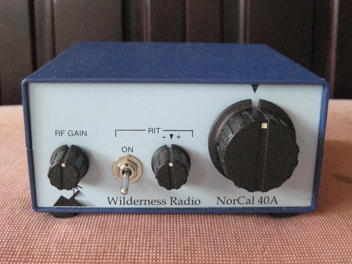The Elecraft K1

At least some of my interest in ham radio can be boiled down to my curiosity. How did they do it? How does it work? Why does it work? My college degree is in Computer Science, not Electrical Engineering, so I needed to start small and work my way up.
Radios do not need to be complicated to work. Like many of you, I imagine, I built a crystal radio and listened to AM broadcasts as a child. It seemed mysterious at the time (and still does, to a degree) that this simple collection of parts: a coil of wire that I sanded and tapped to tune, a small “diode” (whatever that was), and some earphones could take radio waves from the air and create sounds.
One of the reasons I became a ham was to learn a little more about how radios work. I think that’s why I gravitated to QRP stuff so early in my adventure. The radios were small and simple (at least compared to the big Icom I had on my desk), and yet they were “complete” transceivers. As a kid I would take apart anything I could find to see how it worked. (My survival probably depended on my being able to put things back together; I was relentless!) These small radios seemed like a gateway to learning.
Back in the early 1990s, Wayne Burdick, N6KR, designed a small, trail-friendly transceiver for 40m that was to become the NorCal (Northern California QRP club) 40. He completed this design by himself in three days! There wasn’t much to this radio. It had a couple of knobs, a BNC antenna connection, and two jacks for headphones and key. Later versions of the device produced by Wilderness Radio (called the NorCal 40A) included a keyer with memories, a boon to anybody working portably.

Wilderness Radio’s NorCal 40A photo from K7NIB (used without permission)
A destination of note for all things QRP and radio is the Chuck Adams, K7QO, website. In particular, I’ll point you to the catalog of YouTube videos Chuck has discussing many aspects of radio design. There are a couple of different builds for the NorCal 40A: one done Manhattan-style and another done on a PCB. You don’t need the kit to build the radio! Chuck shows you how to do-it-yourself.
http://www.k7qo.com/k7qo_youtubes.html

Me with Chuck Adams, K7QO, in 2006 at the Four Days in May convention in Fairborn, Ohio.
Alas, like so many things in our kit world, this radio is no longer in production. That is a shame for there is a whole book dedicated to teaching Electrical Engineering principles call “The Electronics of Radio” by David B. Rutledge, KN6EK, that uses the NorCal 40 throughout. The book is still available on Amazon.
https://www.amazon.com/dp/0521646456/
The book walks students through filters, transformers, transistor switches and amplifiers, oscillators, and mixers, all using the NorCal 40 as the example. As students build up the radio they learn how each piece works, and how it all works together. I recommend this book even if you never intend to build this radio.

Where this story picks up, though, is when Wayne Burdick and Erick Swartz, WA6HHQ) start the company Elecraft. Wayne’s NorCal 40 proved there was a market for radio kits, and radios with hot receivers and very-low power consumption. Their first offering was the K2, a multi-band radio. It was not unusual for DXpeditions to carry these Elecraft K2s to faraway places because of their exceptional performance. You can still buy K2 kits ($799.95).
Elecraft K2 transceiver. Photo credit B. Scott Andersen, NE1RD.
While the K2 is a wonderful radio, it isn’t exactly trail friendly. Here I am in San Francisco’s Golden Gate Park with my trusty K2. I was going to do some winter sprint contest of some kind, but the final transistor was shorted to the case and the radio wouldn’t work. I walked to a nearby Radio Shack® and bought enough tools to at least open up the radio and diagnose the problem. (I miss Radio Shack!)

Me at a picnic table in San Francisco’s Golden Gate Park in 2005.
A simplified version of this radio, the K1, came soon after the K2. The K1, unfortunately, is no longer in production. Some combination of lower demand and problems finding the through-hole parts needed by the kit doomed it. Nevertheless, the manuals for the radio are still available on the Elecraft website. You can download the complete K1 manual here: K1 MANUAL.

Elecraft K1. Photo credit B. Scott Andersen, NE1RD.
There are complete schematics for the radio and this wonderful block diagram illustrating how the radio components fit together.

K1 block diagram from the Elecraft manual. Used without permission.
I highly recommend fetching this gem if only to have the block diagram and the radio’s schematic handy. I printed out the schematic (just four pages, and really only two that are interesting) and carried them with me everywhere for a couple of years. I would occasionally take out these pages and follow along the signal path to see how Wayne Burdick and Eric Swartz did it.

Me with Eric Swartz (WA6HHQ) in Dayton 2006
The K1 manuals are free. Chuck Adams’ YouTube videos are free. There is a lot you can do to learn about how radios work by “taking apart” some of the best designs QRP radios have ever had. The K1 is such a radio.
Please take a moment and get that Elecraft manual for the K1 and give it a look. Skip past all the assembly steps and go straight to the back with the schematics and block diagrams.
I’ll go into the RockMite in my next article and walk through how the radio works.
April 14, 2019


